Econ 326 Assignment 2: Canadian Inuit Women Folate Level Study
VerifiedAdded on 2022/10/10
|39
|8202
|400
Report
AI Summary
This assignment analyzes a research paper on red blood cell folate levels in Canadian Inuit women, focusing on the influence of factors like food security, body mass index, smoking, education, and vitamin use. The report examines the study's background, data description, methodology, and empirical challenges. It discusses the use of linear regression and descriptive statistics, the impact of smoking and vitamin supplements, and the prevalence of low folate levels. The assignment also reviews related literature on anemia in Inuit women and high red blood cell folate concentrations. It assesses the credibility of the results, considering factors like food insecurity and smoking, and suggests potential future frameworks to strengthen the empirical strategy. The report also includes the student's analysis using STATA, addressing the assignment brief's requirements.
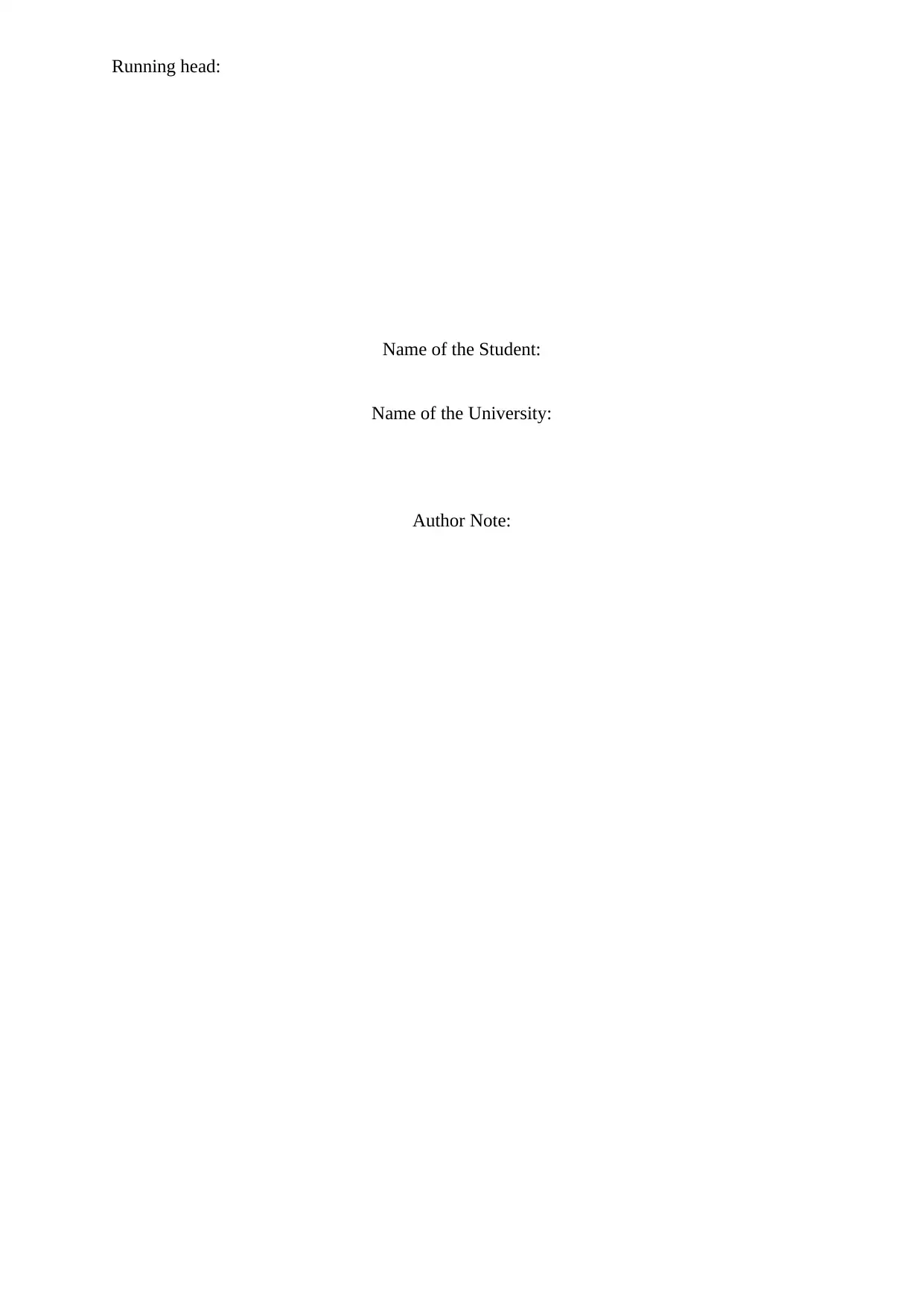
Running head:
Name of the Student:
Name of the University:
Author Note:
Name of the Student:
Name of the University:
Author Note:
Paraphrase This Document
Need a fresh take? Get an instant paraphrase of this document with our AI Paraphraser
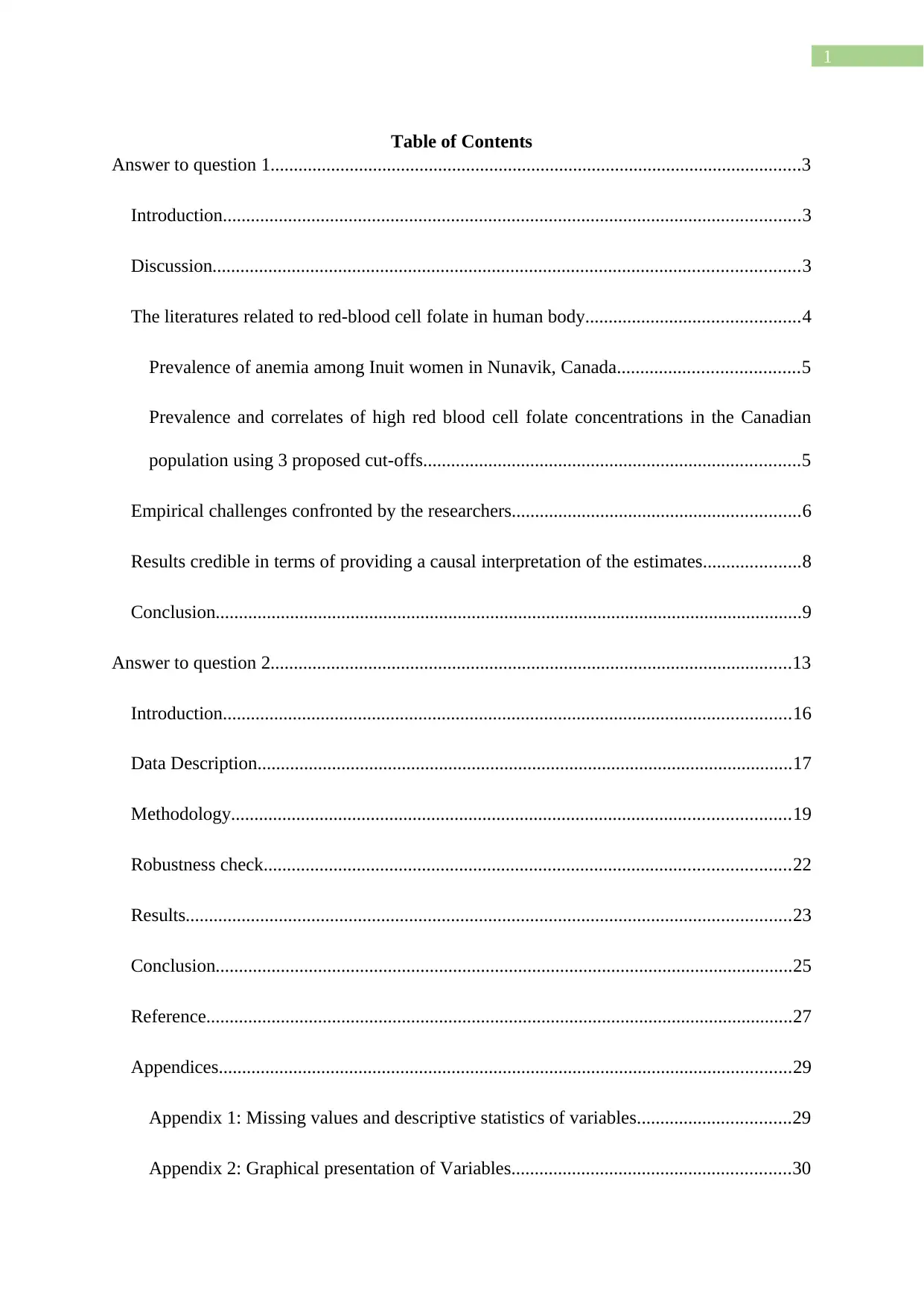
1
Table of Contents
Answer to question 1..................................................................................................................3
Introduction............................................................................................................................3
Discussion..............................................................................................................................3
The literatures related to red-blood cell folate in human body..............................................4
Prevalence of anemia among Inuit women in Nunavik, Canada.......................................5
Prevalence and correlates of high red blood cell folate concentrations in the Canadian
population using 3 proposed cut-offs.................................................................................5
Empirical challenges confronted by the researchers..............................................................6
Results credible in terms of providing a causal interpretation of the estimates.....................8
Conclusion..............................................................................................................................9
Answer to question 2................................................................................................................13
Introduction..........................................................................................................................16
Data Description...................................................................................................................17
Methodology........................................................................................................................19
Robustness check.................................................................................................................22
Results..................................................................................................................................23
Conclusion............................................................................................................................25
Reference..............................................................................................................................27
Appendices...........................................................................................................................29
Appendix 1: Missing values and descriptive statistics of variables.................................29
Appendix 2: Graphical presentation of Variables............................................................30
Table of Contents
Answer to question 1..................................................................................................................3
Introduction............................................................................................................................3
Discussion..............................................................................................................................3
The literatures related to red-blood cell folate in human body..............................................4
Prevalence of anemia among Inuit women in Nunavik, Canada.......................................5
Prevalence and correlates of high red blood cell folate concentrations in the Canadian
population using 3 proposed cut-offs.................................................................................5
Empirical challenges confronted by the researchers..............................................................6
Results credible in terms of providing a causal interpretation of the estimates.....................8
Conclusion..............................................................................................................................9
Answer to question 2................................................................................................................13
Introduction..........................................................................................................................16
Data Description...................................................................................................................17
Methodology........................................................................................................................19
Robustness check.................................................................................................................22
Results..................................................................................................................................23
Conclusion............................................................................................................................25
Reference..............................................................................................................................27
Appendices...........................................................................................................................29
Appendix 1: Missing values and descriptive statistics of variables.................................29
Appendix 2: Graphical presentation of Variables............................................................30
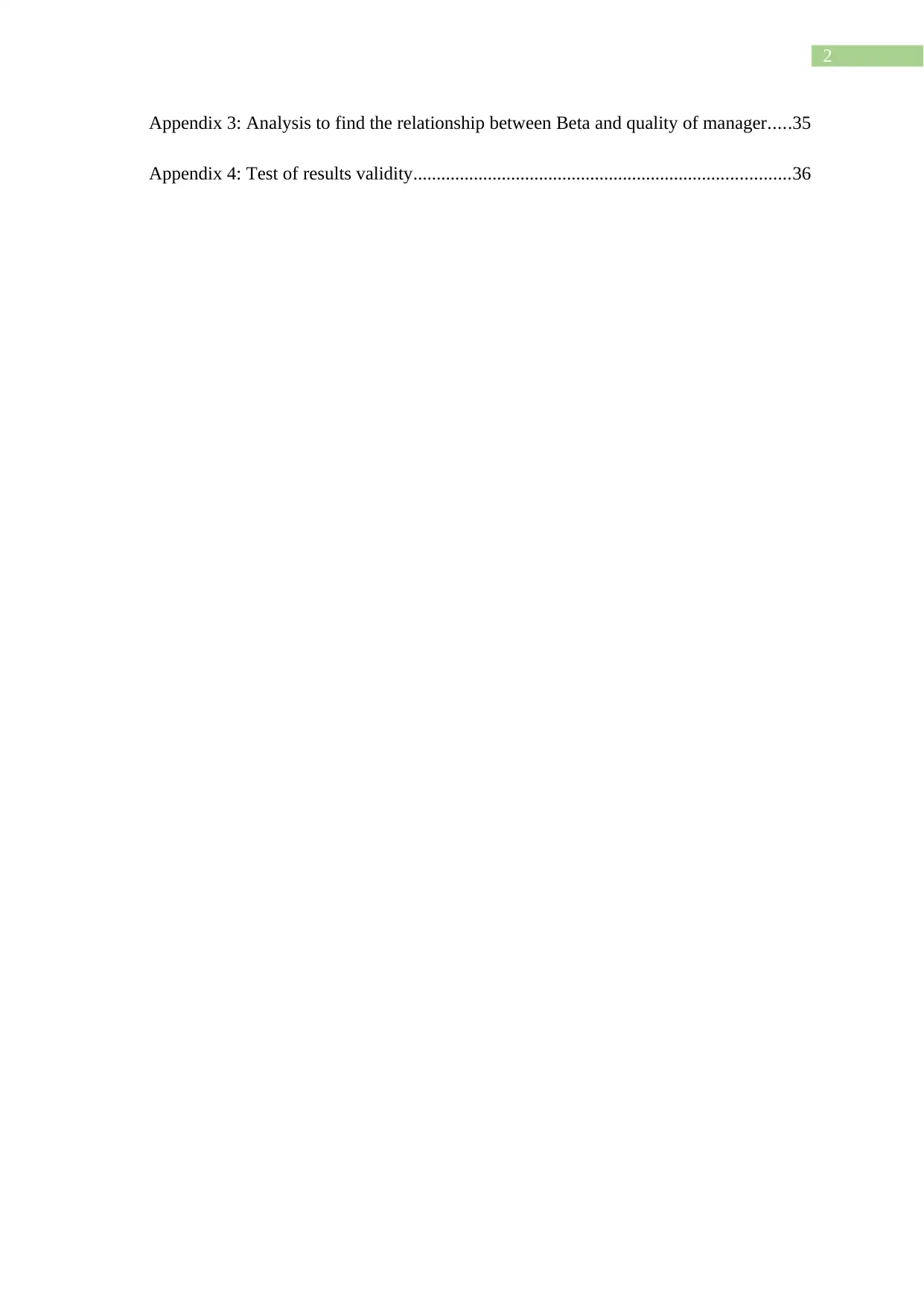
2
Appendix 3: Analysis to find the relationship between Beta and quality of manager.....35
Appendix 4: Test of results validity.................................................................................36
Appendix 3: Analysis to find the relationship between Beta and quality of manager.....35
Appendix 4: Test of results validity.................................................................................36
⊘ This is a preview!⊘
Do you want full access?
Subscribe today to unlock all pages.

Trusted by 1+ million students worldwide
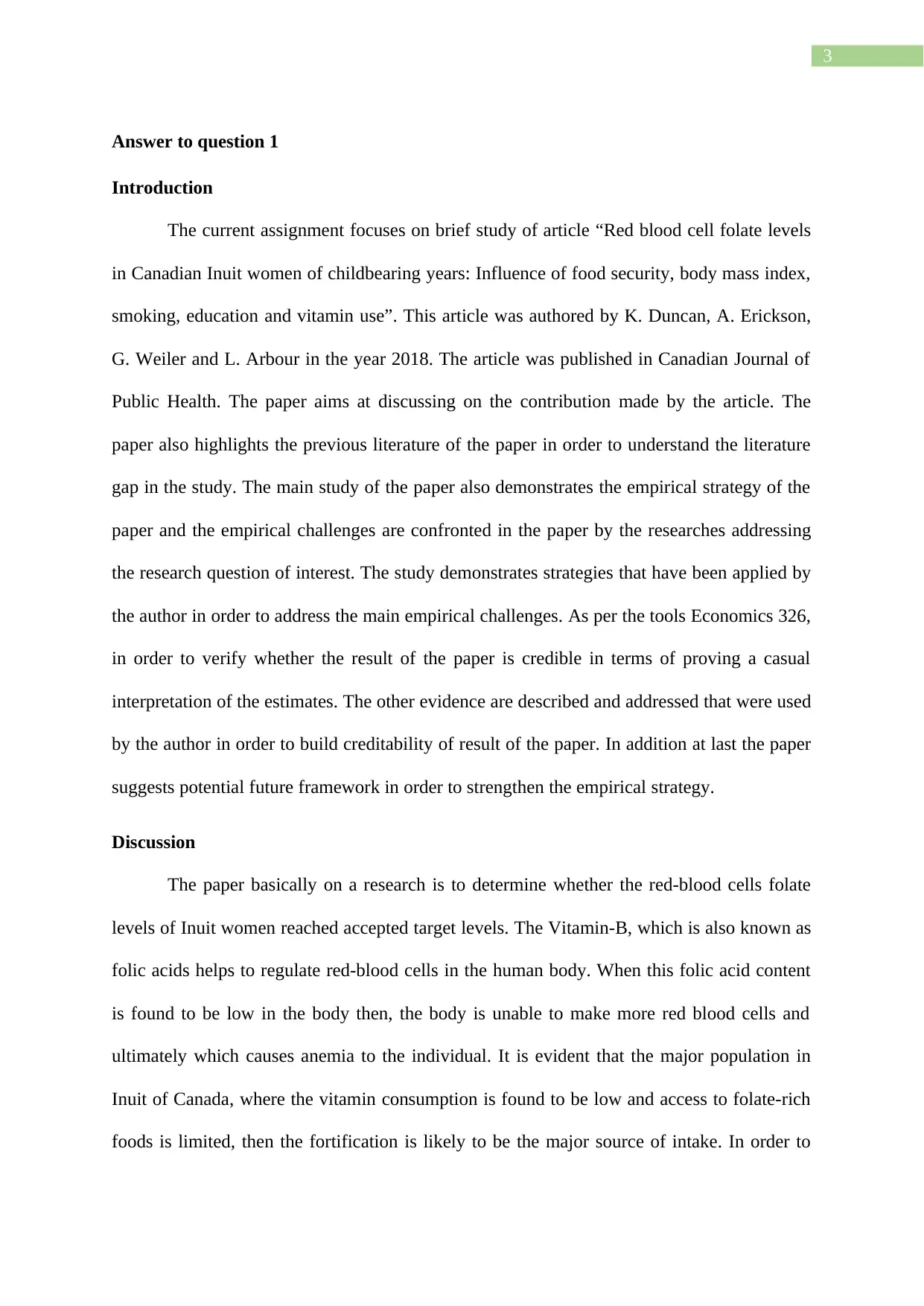
3
Answer to question 1
Introduction
The current assignment focuses on brief study of article “Red blood cell folate levels
in Canadian Inuit women of childbearing years: Influence of food security, body mass index,
smoking, education and vitamin use”. This article was authored by K. Duncan, A. Erickson,
G. Weiler and L. Arbour in the year 2018. The article was published in Canadian Journal of
Public Health. The paper aims at discussing on the contribution made by the article. The
paper also highlights the previous literature of the paper in order to understand the literature
gap in the study. The main study of the paper also demonstrates the empirical strategy of the
paper and the empirical challenges are confronted in the paper by the researches addressing
the research question of interest. The study demonstrates strategies that have been applied by
the author in order to address the main empirical challenges. As per the tools Economics 326,
in order to verify whether the result of the paper is credible in terms of proving a casual
interpretation of the estimates. The other evidence are described and addressed that were used
by the author in order to build creditability of result of the paper. In addition at last the paper
suggests potential future framework in order to strengthen the empirical strategy.
Discussion
The paper basically on a research is to determine whether the red-blood cells folate
levels of Inuit women reached accepted target levels. The Vitamin-B, which is also known as
folic acids helps to regulate red-blood cells in the human body. When this folic acid content
is found to be low in the body then, the body is unable to make more red blood cells and
ultimately which causes anemia to the individual. It is evident that the major population in
Inuit of Canada, where the vitamin consumption is found to be low and access to folate-rich
foods is limited, then the fortification is likely to be the major source of intake. In order to
Answer to question 1
Introduction
The current assignment focuses on brief study of article “Red blood cell folate levels
in Canadian Inuit women of childbearing years: Influence of food security, body mass index,
smoking, education and vitamin use”. This article was authored by K. Duncan, A. Erickson,
G. Weiler and L. Arbour in the year 2018. The article was published in Canadian Journal of
Public Health. The paper aims at discussing on the contribution made by the article. The
paper also highlights the previous literature of the paper in order to understand the literature
gap in the study. The main study of the paper also demonstrates the empirical strategy of the
paper and the empirical challenges are confronted in the paper by the researches addressing
the research question of interest. The study demonstrates strategies that have been applied by
the author in order to address the main empirical challenges. As per the tools Economics 326,
in order to verify whether the result of the paper is credible in terms of proving a casual
interpretation of the estimates. The other evidence are described and addressed that were used
by the author in order to build creditability of result of the paper. In addition at last the paper
suggests potential future framework in order to strengthen the empirical strategy.
Discussion
The paper basically on a research is to determine whether the red-blood cells folate
levels of Inuit women reached accepted target levels. The Vitamin-B, which is also known as
folic acids helps to regulate red-blood cells in the human body. When this folic acid content
is found to be low in the body then, the body is unable to make more red blood cells and
ultimately which causes anemia to the individual. It is evident that the major population in
Inuit of Canada, where the vitamin consumption is found to be low and access to folate-rich
foods is limited, then the fortification is likely to be the major source of intake. In order to
Paraphrase This Document
Need a fresh take? Get an instant paraphrase of this document with our AI Paraphraser
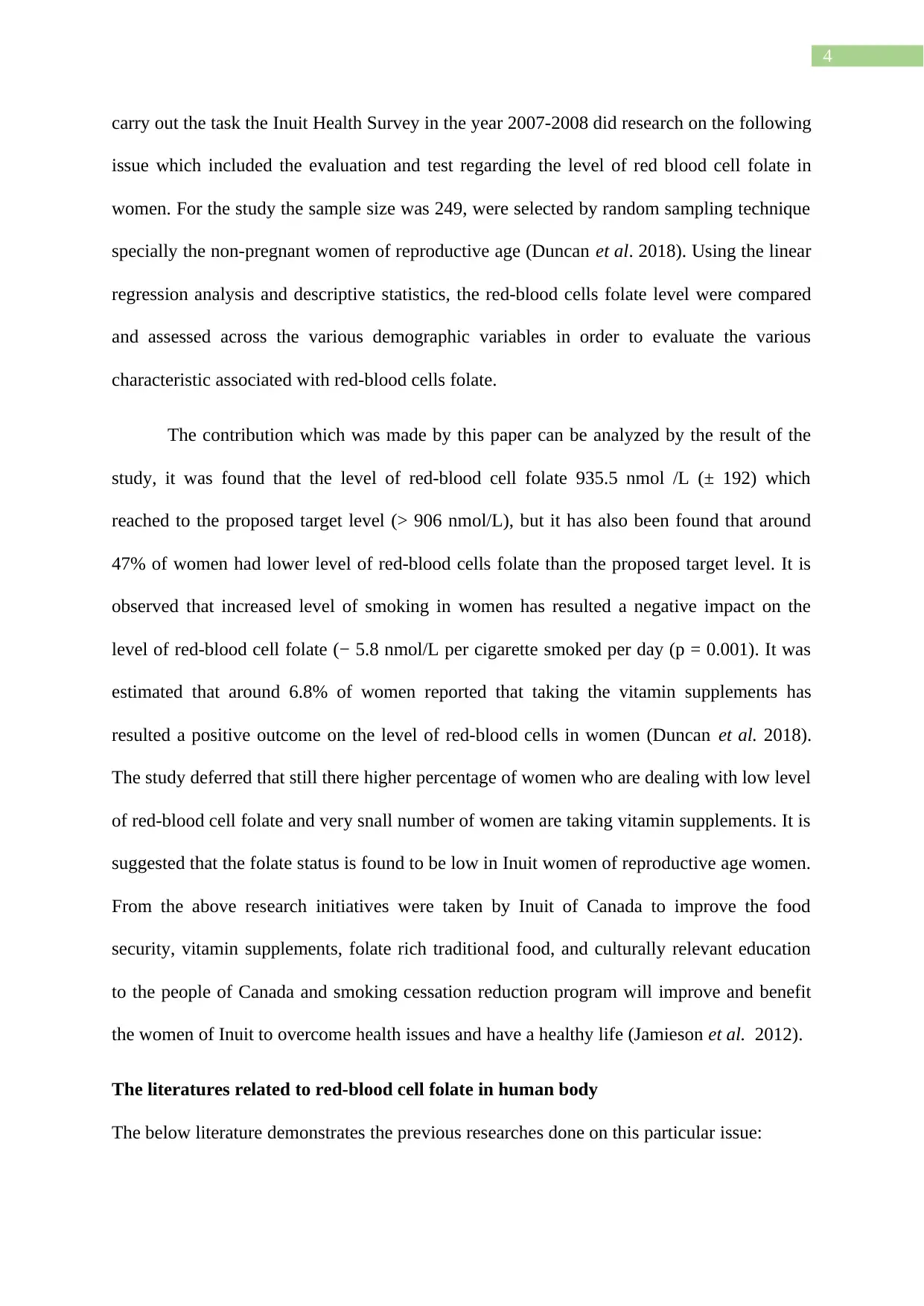
4
carry out the task the Inuit Health Survey in the year 2007-2008 did research on the following
issue which included the evaluation and test regarding the level of red blood cell folate in
women. For the study the sample size was 249, were selected by random sampling technique
specially the non-pregnant women of reproductive age (Duncan et al. 2018). Using the linear
regression analysis and descriptive statistics, the red-blood cells folate level were compared
and assessed across the various demographic variables in order to evaluate the various
characteristic associated with red-blood cells folate.
The contribution which was made by this paper can be analyzed by the result of the
study, it was found that the level of red-blood cell folate 935.5 nmol /L (± 192) which
reached to the proposed target level (> 906 nmol/L), but it has also been found that around
47% of women had lower level of red-blood cells folate than the proposed target level. It is
observed that increased level of smoking in women has resulted a negative impact on the
level of red-blood cell folate (− 5.8 nmol/L per cigarette smoked per day (p = 0.001). It was
estimated that around 6.8% of women reported that taking the vitamin supplements has
resulted a positive outcome on the level of red-blood cells in women (Duncan et al. 2018).
The study deferred that still there higher percentage of women who are dealing with low level
of red-blood cell folate and very snall number of women are taking vitamin supplements. It is
suggested that the folate status is found to be low in Inuit women of reproductive age women.
From the above research initiatives were taken by Inuit of Canada to improve the food
security, vitamin supplements, folate rich traditional food, and culturally relevant education
to the people of Canada and smoking cessation reduction program will improve and benefit
the women of Inuit to overcome health issues and have a healthy life (Jamieson et al. 2012).
The literatures related to red-blood cell folate in human body
The below literature demonstrates the previous researches done on this particular issue:
carry out the task the Inuit Health Survey in the year 2007-2008 did research on the following
issue which included the evaluation and test regarding the level of red blood cell folate in
women. For the study the sample size was 249, were selected by random sampling technique
specially the non-pregnant women of reproductive age (Duncan et al. 2018). Using the linear
regression analysis and descriptive statistics, the red-blood cells folate level were compared
and assessed across the various demographic variables in order to evaluate the various
characteristic associated with red-blood cells folate.
The contribution which was made by this paper can be analyzed by the result of the
study, it was found that the level of red-blood cell folate 935.5 nmol /L (± 192) which
reached to the proposed target level (> 906 nmol/L), but it has also been found that around
47% of women had lower level of red-blood cells folate than the proposed target level. It is
observed that increased level of smoking in women has resulted a negative impact on the
level of red-blood cell folate (− 5.8 nmol/L per cigarette smoked per day (p = 0.001). It was
estimated that around 6.8% of women reported that taking the vitamin supplements has
resulted a positive outcome on the level of red-blood cells in women (Duncan et al. 2018).
The study deferred that still there higher percentage of women who are dealing with low level
of red-blood cell folate and very snall number of women are taking vitamin supplements. It is
suggested that the folate status is found to be low in Inuit women of reproductive age women.
From the above research initiatives were taken by Inuit of Canada to improve the food
security, vitamin supplements, folate rich traditional food, and culturally relevant education
to the people of Canada and smoking cessation reduction program will improve and benefit
the women of Inuit to overcome health issues and have a healthy life (Jamieson et al. 2012).
The literatures related to red-blood cell folate in human body
The below literature demonstrates the previous researches done on this particular issue:
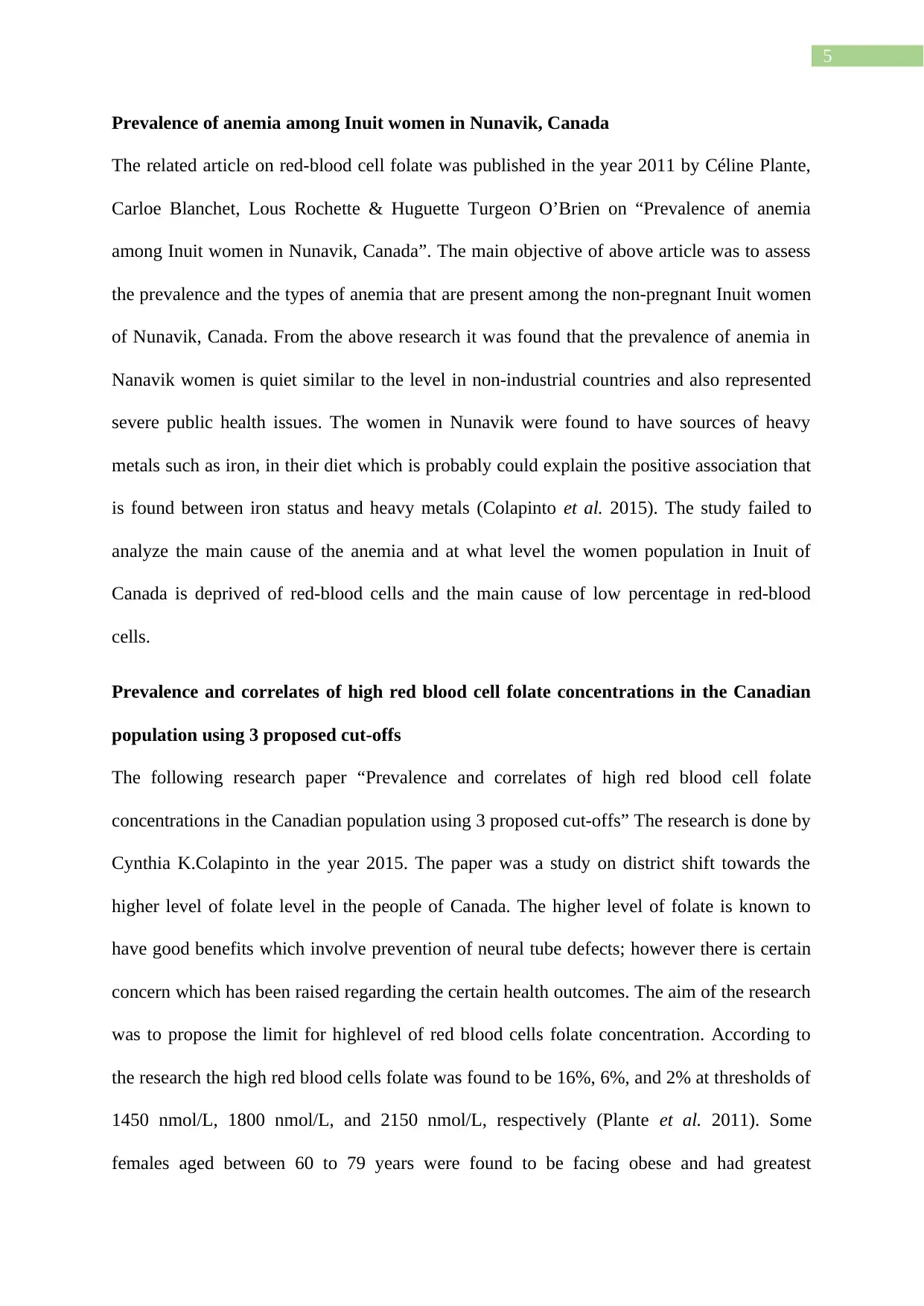
5
Prevalence of anemia among Inuit women in Nunavik, Canada
The related article on red-blood cell folate was published in the year 2011 by Céline Plante,
Carloe Blanchet, Lous Rochette & Huguette Turgeon O’Brien on “Prevalence of anemia
among Inuit women in Nunavik, Canada”. The main objective of above article was to assess
the prevalence and the types of anemia that are present among the non-pregnant Inuit women
of Nunavik, Canada. From the above research it was found that the prevalence of anemia in
Nanavik women is quiet similar to the level in non-industrial countries and also represented
severe public health issues. The women in Nunavik were found to have sources of heavy
metals such as iron, in their diet which is probably could explain the positive association that
is found between iron status and heavy metals (Colapinto et al. 2015). The study failed to
analyze the main cause of the anemia and at what level the women population in Inuit of
Canada is deprived of red-blood cells and the main cause of low percentage in red-blood
cells.
Prevalence and correlates of high red blood cell folate concentrations in the Canadian
population using 3 proposed cut-offs
The following research paper “Prevalence and correlates of high red blood cell folate
concentrations in the Canadian population using 3 proposed cut-offs” The research is done by
Cynthia K.Colapinto in the year 2015. The paper was a study on district shift towards the
higher level of folate level in the people of Canada. The higher level of folate is known to
have good benefits which involve prevention of neural tube defects; however there is certain
concern which has been raised regarding the certain health outcomes. The aim of the research
was to propose the limit for highlevel of red blood cells folate concentration. According to
the research the high red blood cells folate was found to be 16%, 6%, and 2% at thresholds of
1450 nmol/L, 1800 nmol/L, and 2150 nmol/L, respectively (Plante et al. 2011). Some
females aged between 60 to 79 years were found to be facing obese and had greatest
Prevalence of anemia among Inuit women in Nunavik, Canada
The related article on red-blood cell folate was published in the year 2011 by Céline Plante,
Carloe Blanchet, Lous Rochette & Huguette Turgeon O’Brien on “Prevalence of anemia
among Inuit women in Nunavik, Canada”. The main objective of above article was to assess
the prevalence and the types of anemia that are present among the non-pregnant Inuit women
of Nunavik, Canada. From the above research it was found that the prevalence of anemia in
Nanavik women is quiet similar to the level in non-industrial countries and also represented
severe public health issues. The women in Nunavik were found to have sources of heavy
metals such as iron, in their diet which is probably could explain the positive association that
is found between iron status and heavy metals (Colapinto et al. 2015). The study failed to
analyze the main cause of the anemia and at what level the women population in Inuit of
Canada is deprived of red-blood cells and the main cause of low percentage in red-blood
cells.
Prevalence and correlates of high red blood cell folate concentrations in the Canadian
population using 3 proposed cut-offs
The following research paper “Prevalence and correlates of high red blood cell folate
concentrations in the Canadian population using 3 proposed cut-offs” The research is done by
Cynthia K.Colapinto in the year 2015. The paper was a study on district shift towards the
higher level of folate level in the people of Canada. The higher level of folate is known to
have good benefits which involve prevention of neural tube defects; however there is certain
concern which has been raised regarding the certain health outcomes. The aim of the research
was to propose the limit for highlevel of red blood cells folate concentration. According to
the research the high red blood cells folate was found to be 16%, 6%, and 2% at thresholds of
1450 nmol/L, 1800 nmol/L, and 2150 nmol/L, respectively (Plante et al. 2011). Some
females aged between 60 to 79 years were found to be facing obese and had greatest
⊘ This is a preview!⊘
Do you want full access?
Subscribe today to unlock all pages.

Trusted by 1+ million students worldwide
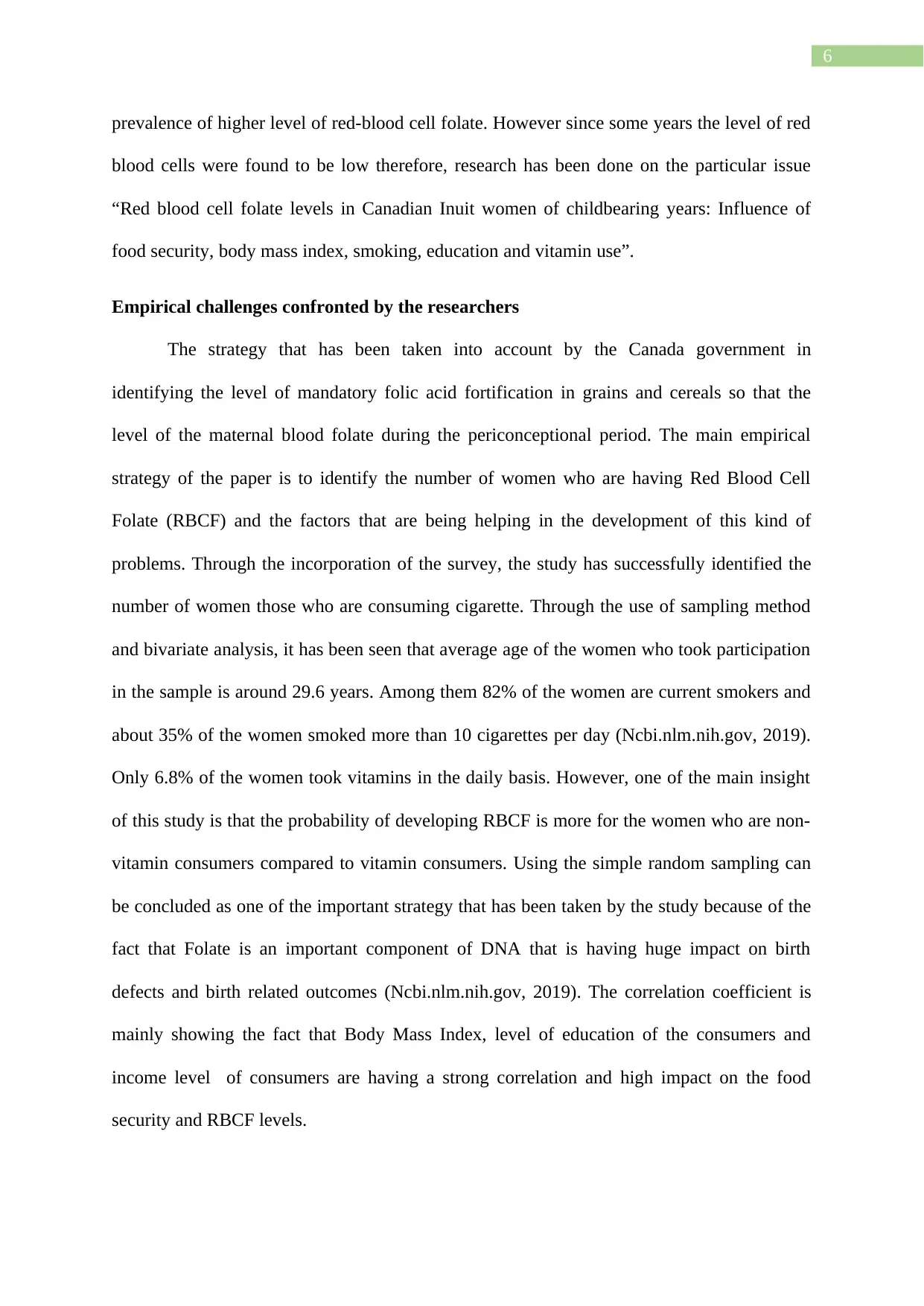
6
prevalence of higher level of red-blood cell folate. However since some years the level of red
blood cells were found to be low therefore, research has been done on the particular issue
“Red blood cell folate levels in Canadian Inuit women of childbearing years: Influence of
food security, body mass index, smoking, education and vitamin use”.
Empirical challenges confronted by the researchers
The strategy that has been taken into account by the Canada government in
identifying the level of mandatory folic acid fortification in grains and cereals so that the
level of the maternal blood folate during the periconceptional period. The main empirical
strategy of the paper is to identify the number of women who are having Red Blood Cell
Folate (RBCF) and the factors that are being helping in the development of this kind of
problems. Through the incorporation of the survey, the study has successfully identified the
number of women those who are consuming cigarette. Through the use of sampling method
and bivariate analysis, it has been seen that average age of the women who took participation
in the sample is around 29.6 years. Among them 82% of the women are current smokers and
about 35% of the women smoked more than 10 cigarettes per day (Ncbi.nlm.nih.gov, 2019).
Only 6.8% of the women took vitamins in the daily basis. However, one of the main insight
of this study is that the probability of developing RBCF is more for the women who are non-
vitamin consumers compared to vitamin consumers. Using the simple random sampling can
be concluded as one of the important strategy that has been taken by the study because of the
fact that Folate is an important component of DNA that is having huge impact on birth
defects and birth related outcomes (Ncbi.nlm.nih.gov, 2019). The correlation coefficient is
mainly showing the fact that Body Mass Index, level of education of the consumers and
income level of consumers are having a strong correlation and high impact on the food
security and RBCF levels.
prevalence of higher level of red-blood cell folate. However since some years the level of red
blood cells were found to be low therefore, research has been done on the particular issue
“Red blood cell folate levels in Canadian Inuit women of childbearing years: Influence of
food security, body mass index, smoking, education and vitamin use”.
Empirical challenges confronted by the researchers
The strategy that has been taken into account by the Canada government in
identifying the level of mandatory folic acid fortification in grains and cereals so that the
level of the maternal blood folate during the periconceptional period. The main empirical
strategy of the paper is to identify the number of women who are having Red Blood Cell
Folate (RBCF) and the factors that are being helping in the development of this kind of
problems. Through the incorporation of the survey, the study has successfully identified the
number of women those who are consuming cigarette. Through the use of sampling method
and bivariate analysis, it has been seen that average age of the women who took participation
in the sample is around 29.6 years. Among them 82% of the women are current smokers and
about 35% of the women smoked more than 10 cigarettes per day (Ncbi.nlm.nih.gov, 2019).
Only 6.8% of the women took vitamins in the daily basis. However, one of the main insight
of this study is that the probability of developing RBCF is more for the women who are non-
vitamin consumers compared to vitamin consumers. Using the simple random sampling can
be concluded as one of the important strategy that has been taken by the study because of the
fact that Folate is an important component of DNA that is having huge impact on birth
defects and birth related outcomes (Ncbi.nlm.nih.gov, 2019). The correlation coefficient is
mainly showing the fact that Body Mass Index, level of education of the consumers and
income level of consumers are having a strong correlation and high impact on the food
security and RBCF levels.
Paraphrase This Document
Need a fresh take? Get an instant paraphrase of this document with our AI Paraphraser
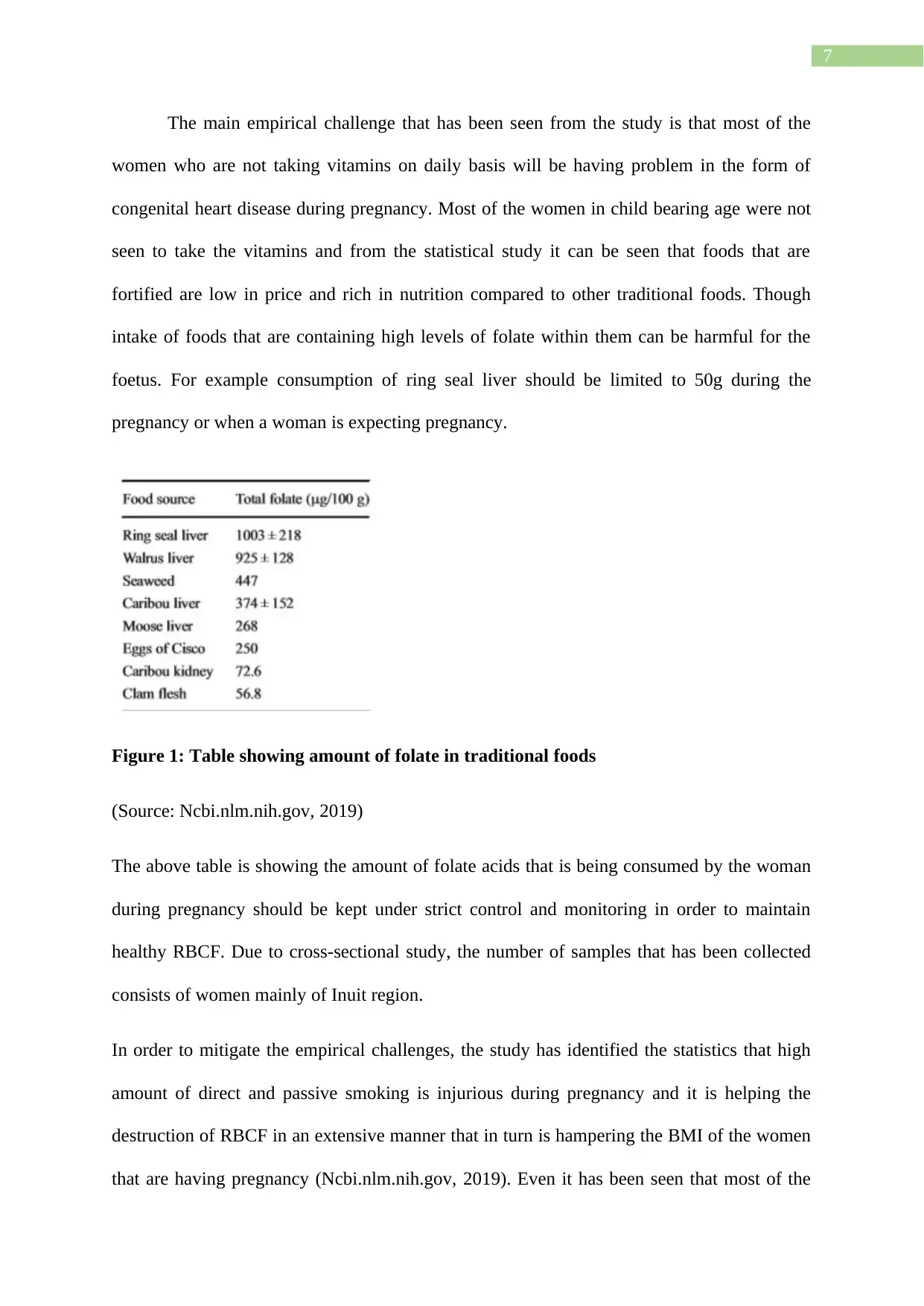
7
The main empirical challenge that has been seen from the study is that most of the
women who are not taking vitamins on daily basis will be having problem in the form of
congenital heart disease during pregnancy. Most of the women in child bearing age were not
seen to take the vitamins and from the statistical study it can be seen that foods that are
fortified are low in price and rich in nutrition compared to other traditional foods. Though
intake of foods that are containing high levels of folate within them can be harmful for the
foetus. For example consumption of ring seal liver should be limited to 50g during the
pregnancy or when a woman is expecting pregnancy.
Figure 1: Table showing amount of folate in traditional foods
(Source: Ncbi.nlm.nih.gov, 2019)
The above table is showing the amount of folate acids that is being consumed by the woman
during pregnancy should be kept under strict control and monitoring in order to maintain
healthy RBCF. Due to cross-sectional study, the number of samples that has been collected
consists of women mainly of Inuit region.
In order to mitigate the empirical challenges, the study has identified the statistics that high
amount of direct and passive smoking is injurious during pregnancy and it is helping the
destruction of RBCF in an extensive manner that in turn is hampering the BMI of the women
that are having pregnancy (Ncbi.nlm.nih.gov, 2019). Even it has been seen that most of the
The main empirical challenge that has been seen from the study is that most of the
women who are not taking vitamins on daily basis will be having problem in the form of
congenital heart disease during pregnancy. Most of the women in child bearing age were not
seen to take the vitamins and from the statistical study it can be seen that foods that are
fortified are low in price and rich in nutrition compared to other traditional foods. Though
intake of foods that are containing high levels of folate within them can be harmful for the
foetus. For example consumption of ring seal liver should be limited to 50g during the
pregnancy or when a woman is expecting pregnancy.
Figure 1: Table showing amount of folate in traditional foods
(Source: Ncbi.nlm.nih.gov, 2019)
The above table is showing the amount of folate acids that is being consumed by the woman
during pregnancy should be kept under strict control and monitoring in order to maintain
healthy RBCF. Due to cross-sectional study, the number of samples that has been collected
consists of women mainly of Inuit region.
In order to mitigate the empirical challenges, the study has identified the statistics that high
amount of direct and passive smoking is injurious during pregnancy and it is helping the
destruction of RBCF in an extensive manner that in turn is hampering the BMI of the women
that are having pregnancy (Ncbi.nlm.nih.gov, 2019). Even it has been seen that most of the
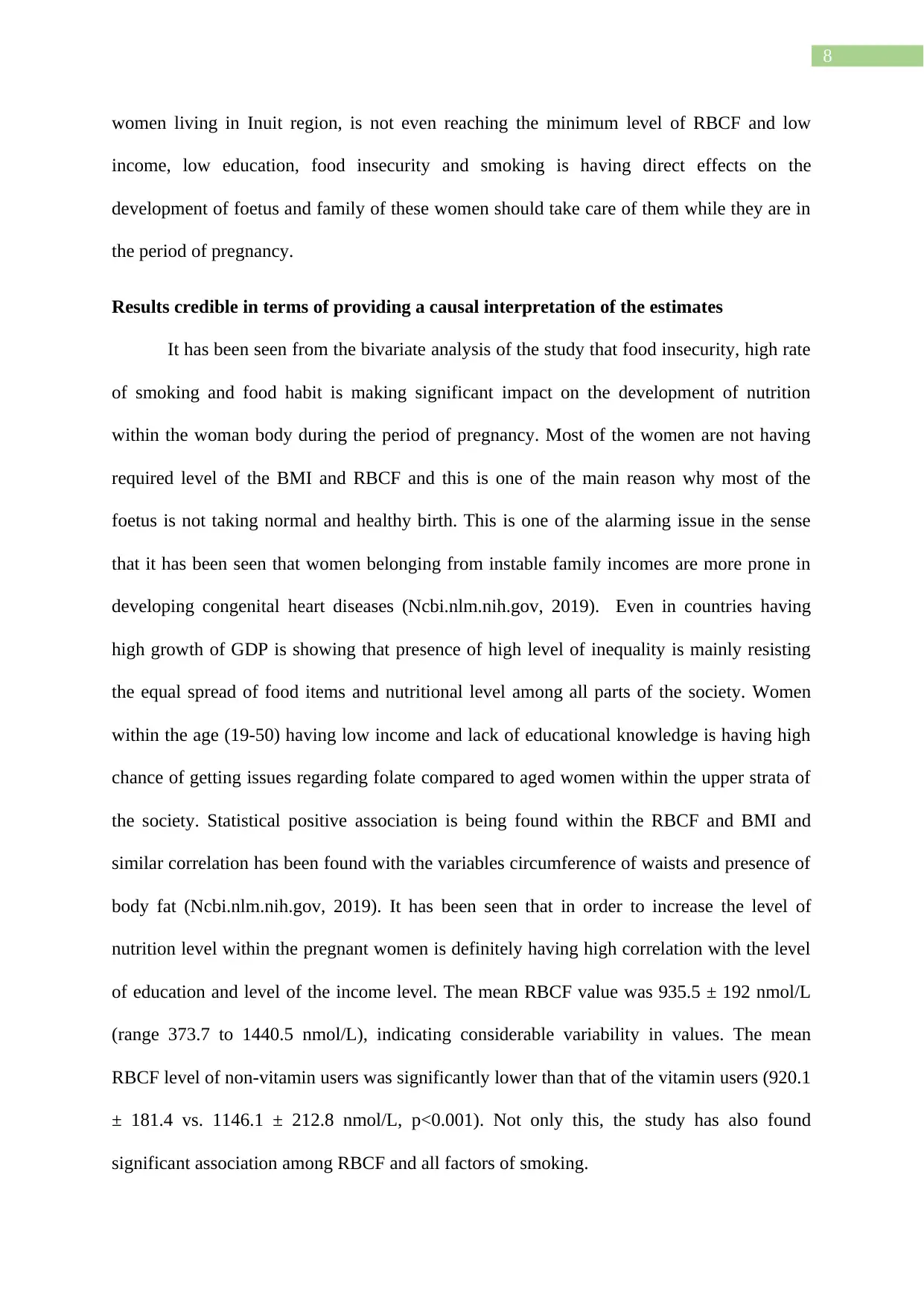
8
women living in Inuit region, is not even reaching the minimum level of RBCF and low
income, low education, food insecurity and smoking is having direct effects on the
development of foetus and family of these women should take care of them while they are in
the period of pregnancy.
Results credible in terms of providing a causal interpretation of the estimates
It has been seen from the bivariate analysis of the study that food insecurity, high rate
of smoking and food habit is making significant impact on the development of nutrition
within the woman body during the period of pregnancy. Most of the women are not having
required level of the BMI and RBCF and this is one of the main reason why most of the
foetus is not taking normal and healthy birth. This is one of the alarming issue in the sense
that it has been seen that women belonging from instable family incomes are more prone in
developing congenital heart diseases (Ncbi.nlm.nih.gov, 2019). Even in countries having
high growth of GDP is showing that presence of high level of inequality is mainly resisting
the equal spread of food items and nutritional level among all parts of the society. Women
within the age (19-50) having low income and lack of educational knowledge is having high
chance of getting issues regarding folate compared to aged women within the upper strata of
the society. Statistical positive association is being found within the RBCF and BMI and
similar correlation has been found with the variables circumference of waists and presence of
body fat (Ncbi.nlm.nih.gov, 2019). It has been seen that in order to increase the level of
nutrition level within the pregnant women is definitely having high correlation with the level
of education and level of the income level. The mean RBCF value was 935.5 ± 192 nmol/L
(range 373.7 to 1440.5 nmol/L), indicating considerable variability in values. The mean
RBCF level of non-vitamin users was significantly lower than that of the vitamin users (920.1
± 181.4 vs. 1146.1 ± 212.8 nmol/L, p<0.001). Not only this, the study has also found
significant association among RBCF and all factors of smoking.
women living in Inuit region, is not even reaching the minimum level of RBCF and low
income, low education, food insecurity and smoking is having direct effects on the
development of foetus and family of these women should take care of them while they are in
the period of pregnancy.
Results credible in terms of providing a causal interpretation of the estimates
It has been seen from the bivariate analysis of the study that food insecurity, high rate
of smoking and food habit is making significant impact on the development of nutrition
within the woman body during the period of pregnancy. Most of the women are not having
required level of the BMI and RBCF and this is one of the main reason why most of the
foetus is not taking normal and healthy birth. This is one of the alarming issue in the sense
that it has been seen that women belonging from instable family incomes are more prone in
developing congenital heart diseases (Ncbi.nlm.nih.gov, 2019). Even in countries having
high growth of GDP is showing that presence of high level of inequality is mainly resisting
the equal spread of food items and nutritional level among all parts of the society. Women
within the age (19-50) having low income and lack of educational knowledge is having high
chance of getting issues regarding folate compared to aged women within the upper strata of
the society. Statistical positive association is being found within the RBCF and BMI and
similar correlation has been found with the variables circumference of waists and presence of
body fat (Ncbi.nlm.nih.gov, 2019). It has been seen that in order to increase the level of
nutrition level within the pregnant women is definitely having high correlation with the level
of education and level of the income level. The mean RBCF value was 935.5 ± 192 nmol/L
(range 373.7 to 1440.5 nmol/L), indicating considerable variability in values. The mean
RBCF level of non-vitamin users was significantly lower than that of the vitamin users (920.1
± 181.4 vs. 1146.1 ± 212.8 nmol/L, p<0.001). Not only this, the study has also found
significant association among RBCF and all factors of smoking.
⊘ This is a preview!⊘
Do you want full access?
Subscribe today to unlock all pages.

Trusted by 1+ million students worldwide
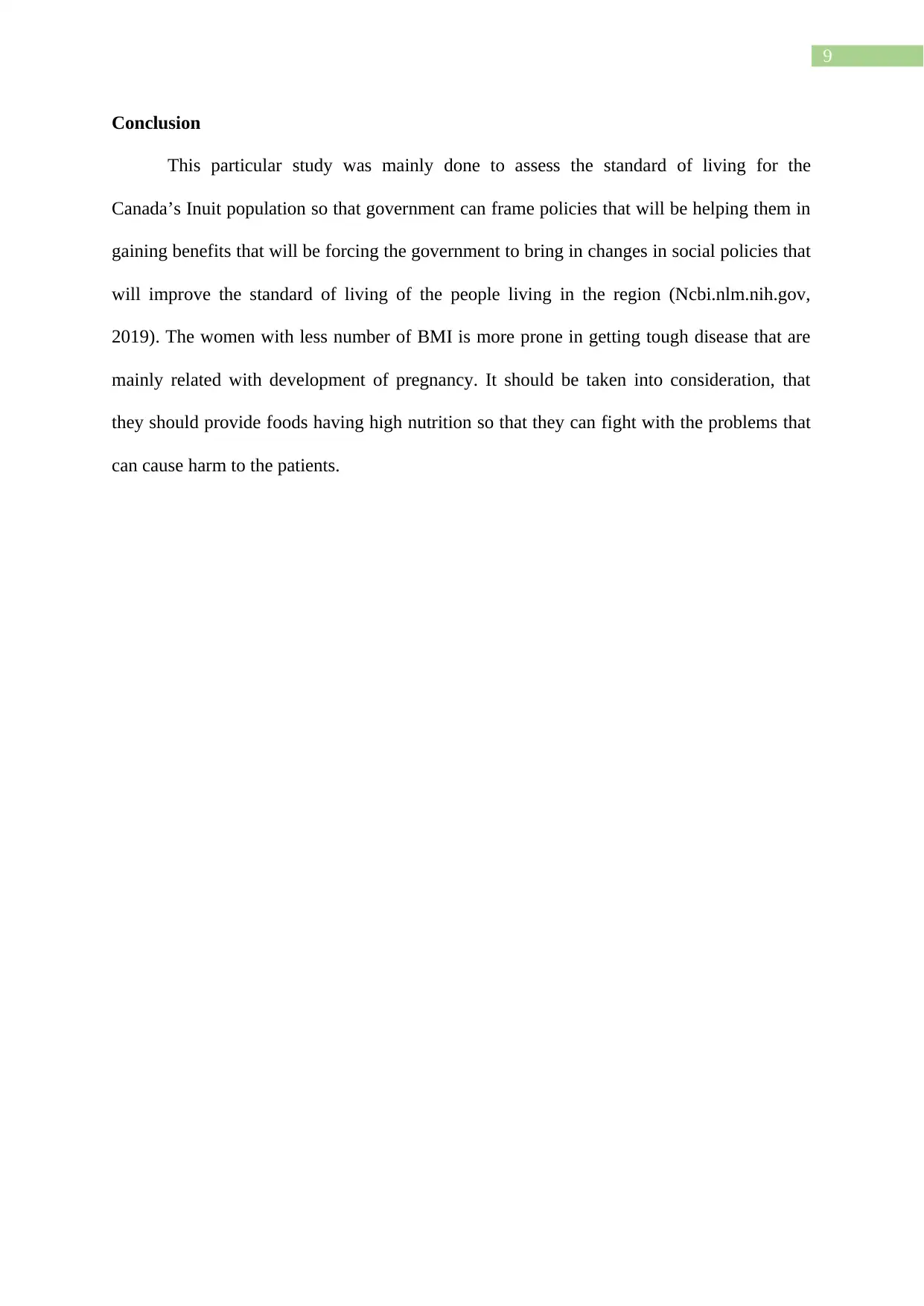
9
Conclusion
This particular study was mainly done to assess the standard of living for the
Canada’s Inuit population so that government can frame policies that will be helping them in
gaining benefits that will be forcing the government to bring in changes in social policies that
will improve the standard of living of the people living in the region (Ncbi.nlm.nih.gov,
2019). The women with less number of BMI is more prone in getting tough disease that are
mainly related with development of pregnancy. It should be taken into consideration, that
they should provide foods having high nutrition so that they can fight with the problems that
can cause harm to the patients.
Conclusion
This particular study was mainly done to assess the standard of living for the
Canada’s Inuit population so that government can frame policies that will be helping them in
gaining benefits that will be forcing the government to bring in changes in social policies that
will improve the standard of living of the people living in the region (Ncbi.nlm.nih.gov,
2019). The women with less number of BMI is more prone in getting tough disease that are
mainly related with development of pregnancy. It should be taken into consideration, that
they should provide foods having high nutrition so that they can fight with the problems that
can cause harm to the patients.
Paraphrase This Document
Need a fresh take? Get an instant paraphrase of this document with our AI Paraphraser
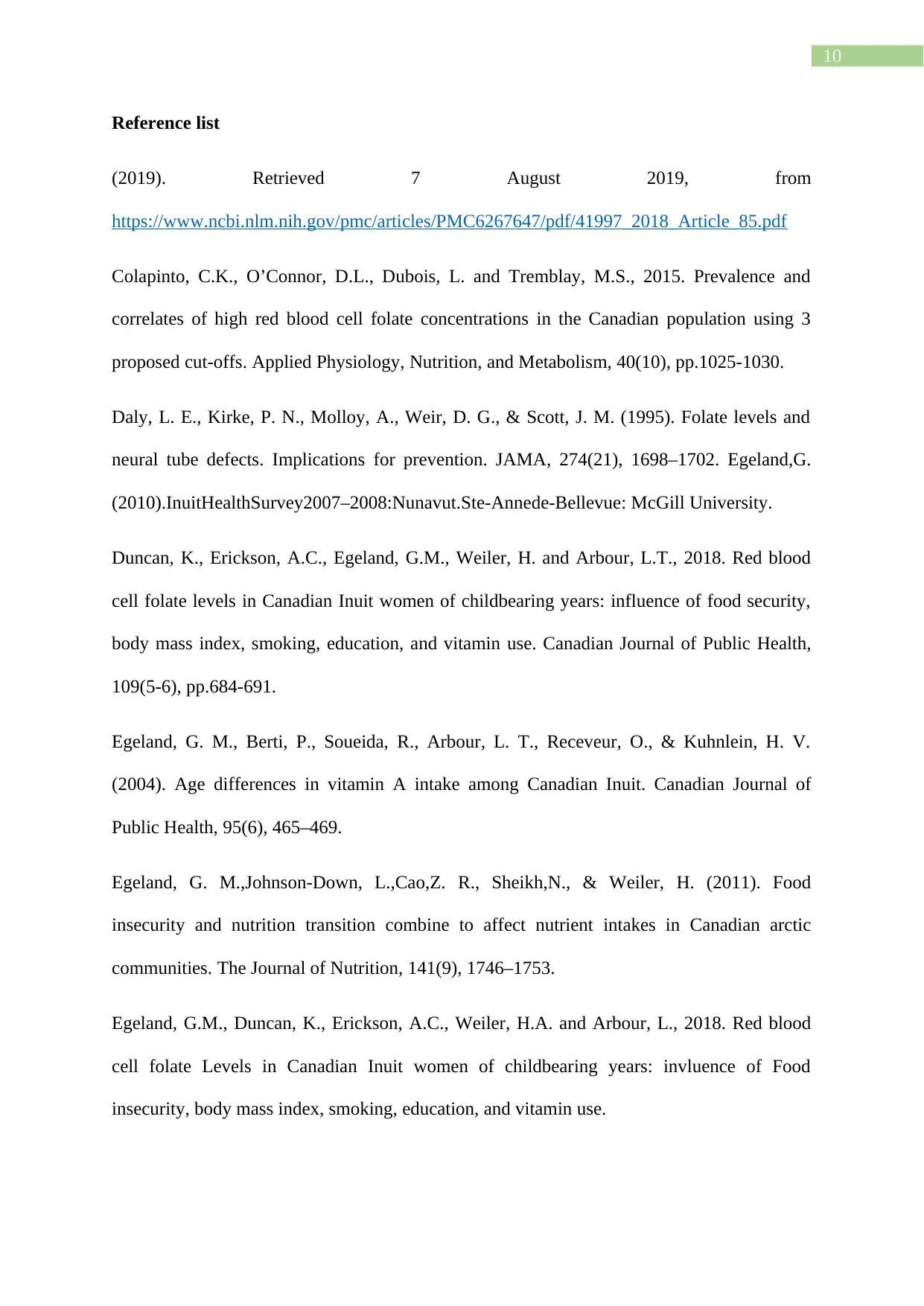
10
Reference list
(2019). Retrieved 7 August 2019, from
https://www.ncbi.nlm.nih.gov/pmc/articles/PMC6267647/pdf/41997_2018_Article_85.pdf
Colapinto, C.K., O’Connor, D.L., Dubois, L. and Tremblay, M.S., 2015. Prevalence and
correlates of high red blood cell folate concentrations in the Canadian population using 3
proposed cut-offs. Applied Physiology, Nutrition, and Metabolism, 40(10), pp.1025-1030.
Daly, L. E., Kirke, P. N., Molloy, A., Weir, D. G., & Scott, J. M. (1995). Folate levels and
neural tube defects. Implications for prevention. JAMA, 274(21), 1698–1702. Egeland,G.
(2010).InuitHealthSurvey2007–2008:Nunavut.Ste-Annede-Bellevue: McGill University.
Duncan, K., Erickson, A.C., Egeland, G.M., Weiler, H. and Arbour, L.T., 2018. Red blood
cell folate levels in Canadian Inuit women of childbearing years: influence of food security,
body mass index, smoking, education, and vitamin use. Canadian Journal of Public Health,
109(5-6), pp.684-691.
Egeland, G. M., Berti, P., Soueida, R., Arbour, L. T., Receveur, O., & Kuhnlein, H. V.
(2004). Age differences in vitamin A intake among Canadian Inuit. Canadian Journal of
Public Health, 95(6), 465–469.
Egeland, G. M.,Johnson-Down, L.,Cao,Z. R., Sheikh,N., & Weiler, H. (2011). Food
insecurity and nutrition transition combine to affect nutrient intakes in Canadian arctic
communities. The Journal of Nutrition, 141(9), 1746–1753.
Egeland, G.M., Duncan, K., Erickson, A.C., Weiler, H.A. and Arbour, L., 2018. Red blood
cell folate Levels in Canadian Inuit women of childbearing years: invluence of Food
insecurity, body mass index, smoking, education, and vitamin use.
Reference list
(2019). Retrieved 7 August 2019, from
https://www.ncbi.nlm.nih.gov/pmc/articles/PMC6267647/pdf/41997_2018_Article_85.pdf
Colapinto, C.K., O’Connor, D.L., Dubois, L. and Tremblay, M.S., 2015. Prevalence and
correlates of high red blood cell folate concentrations in the Canadian population using 3
proposed cut-offs. Applied Physiology, Nutrition, and Metabolism, 40(10), pp.1025-1030.
Daly, L. E., Kirke, P. N., Molloy, A., Weir, D. G., & Scott, J. M. (1995). Folate levels and
neural tube defects. Implications for prevention. JAMA, 274(21), 1698–1702. Egeland,G.
(2010).InuitHealthSurvey2007–2008:Nunavut.Ste-Annede-Bellevue: McGill University.
Duncan, K., Erickson, A.C., Egeland, G.M., Weiler, H. and Arbour, L.T., 2018. Red blood
cell folate levels in Canadian Inuit women of childbearing years: influence of food security,
body mass index, smoking, education, and vitamin use. Canadian Journal of Public Health,
109(5-6), pp.684-691.
Egeland, G. M., Berti, P., Soueida, R., Arbour, L. T., Receveur, O., & Kuhnlein, H. V.
(2004). Age differences in vitamin A intake among Canadian Inuit. Canadian Journal of
Public Health, 95(6), 465–469.
Egeland, G. M.,Johnson-Down, L.,Cao,Z. R., Sheikh,N., & Weiler, H. (2011). Food
insecurity and nutrition transition combine to affect nutrient intakes in Canadian arctic
communities. The Journal of Nutrition, 141(9), 1746–1753.
Egeland, G.M., Duncan, K., Erickson, A.C., Weiler, H.A. and Arbour, L., 2018. Red blood
cell folate Levels in Canadian Inuit women of childbearing years: invluence of Food
insecurity, body mass index, smoking, education, and vitamin use.
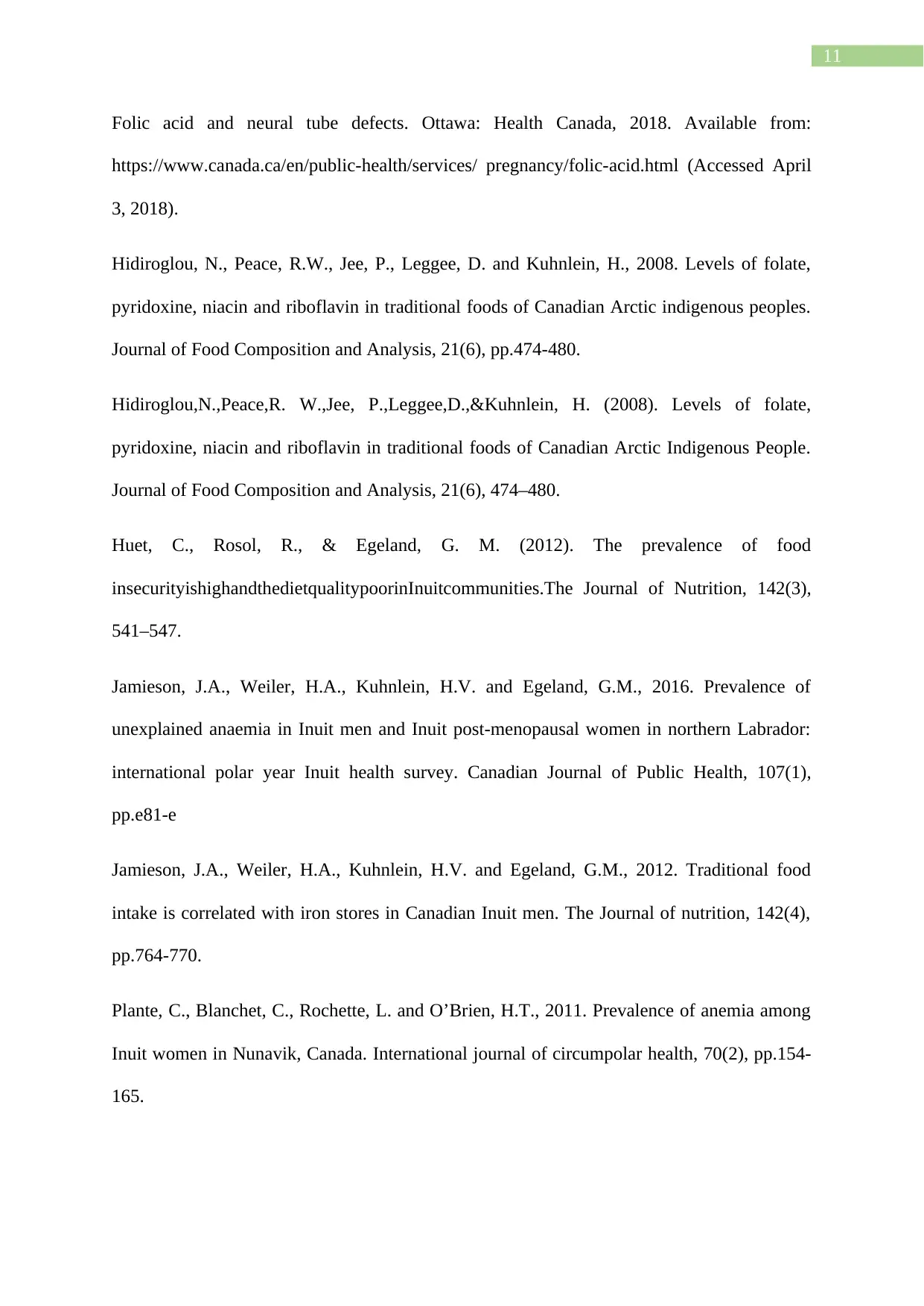
11
Folic acid and neural tube defects. Ottawa: Health Canada, 2018. Available from:
https://www.canada.ca/en/public-health/services/ pregnancy/folic-acid.html (Accessed April
3, 2018).
Hidiroglou, N., Peace, R.W., Jee, P., Leggee, D. and Kuhnlein, H., 2008. Levels of folate,
pyridoxine, niacin and riboflavin in traditional foods of Canadian Arctic indigenous peoples.
Journal of Food Composition and Analysis, 21(6), pp.474-480.
Hidiroglou,N.,Peace,R. W.,Jee, P.,Leggee,D.,&Kuhnlein, H. (2008). Levels of folate,
pyridoxine, niacin and riboflavin in traditional foods of Canadian Arctic Indigenous People.
Journal of Food Composition and Analysis, 21(6), 474–480.
Huet, C., Rosol, R., & Egeland, G. M. (2012). The prevalence of food
insecurityishighandthedietqualitypoorinInuitcommunities.The Journal of Nutrition, 142(3),
541–547.
Jamieson, J.A., Weiler, H.A., Kuhnlein, H.V. and Egeland, G.M., 2016. Prevalence of
unexplained anaemia in Inuit men and Inuit post-menopausal women in northern Labrador:
international polar year Inuit health survey. Canadian Journal of Public Health, 107(1),
pp.e81-e
Jamieson, J.A., Weiler, H.A., Kuhnlein, H.V. and Egeland, G.M., 2012. Traditional food
intake is correlated with iron stores in Canadian Inuit men. The Journal of nutrition, 142(4),
pp.764-770.
Plante, C., Blanchet, C., Rochette, L. and O’Brien, H.T., 2011. Prevalence of anemia among
Inuit women in Nunavik, Canada. International journal of circumpolar health, 70(2), pp.154-
165.
Folic acid and neural tube defects. Ottawa: Health Canada, 2018. Available from:
https://www.canada.ca/en/public-health/services/ pregnancy/folic-acid.html (Accessed April
3, 2018).
Hidiroglou, N., Peace, R.W., Jee, P., Leggee, D. and Kuhnlein, H., 2008. Levels of folate,
pyridoxine, niacin and riboflavin in traditional foods of Canadian Arctic indigenous peoples.
Journal of Food Composition and Analysis, 21(6), pp.474-480.
Hidiroglou,N.,Peace,R. W.,Jee, P.,Leggee,D.,&Kuhnlein, H. (2008). Levels of folate,
pyridoxine, niacin and riboflavin in traditional foods of Canadian Arctic Indigenous People.
Journal of Food Composition and Analysis, 21(6), 474–480.
Huet, C., Rosol, R., & Egeland, G. M. (2012). The prevalence of food
insecurityishighandthedietqualitypoorinInuitcommunities.The Journal of Nutrition, 142(3),
541–547.
Jamieson, J.A., Weiler, H.A., Kuhnlein, H.V. and Egeland, G.M., 2016. Prevalence of
unexplained anaemia in Inuit men and Inuit post-menopausal women in northern Labrador:
international polar year Inuit health survey. Canadian Journal of Public Health, 107(1),
pp.e81-e
Jamieson, J.A., Weiler, H.A., Kuhnlein, H.V. and Egeland, G.M., 2012. Traditional food
intake is correlated with iron stores in Canadian Inuit men. The Journal of nutrition, 142(4),
pp.764-770.
Plante, C., Blanchet, C., Rochette, L. and O’Brien, H.T., 2011. Prevalence of anemia among
Inuit women in Nunavik, Canada. International journal of circumpolar health, 70(2), pp.154-
165.
⊘ This is a preview!⊘
Do you want full access?
Subscribe today to unlock all pages.

Trusted by 1+ million students worldwide
1 out of 39
Your All-in-One AI-Powered Toolkit for Academic Success.
+13062052269
info@desklib.com
Available 24*7 on WhatsApp / Email
![[object Object]](/_next/static/media/star-bottom.7253800d.svg)
Unlock your academic potential
Copyright © 2020–2025 A2Z Services. All Rights Reserved. Developed and managed by ZUCOL.